R.M.S. Mauretania (1) 1906 to 1935
Use Google Chrome for this Web Page to load perfectly!
Please Note: All ssMaritime and other related maritime
sites are 100% non-commercial and privately owned, thus ssmaritime is NOT
associated with any shipping company or any other organisation! Although the
author has worked and been involved in the passenger shipping industry for well
over 60 years, but due to his old age and poor health, he was forced to retire.
Yet, he has completed well over 1,435 Classic Liners, Passenger-Cargo Liners as
well as humble converted C3 converted Migrant Liners, which has transported
countless thousands folk to the new world, as well on vacations’. I trust
the features online will continue to provide Classic Liner and Ship enthusiasts
both the information they are seeking, but more so provide a great deal of
pleasure and relive many happy memories!
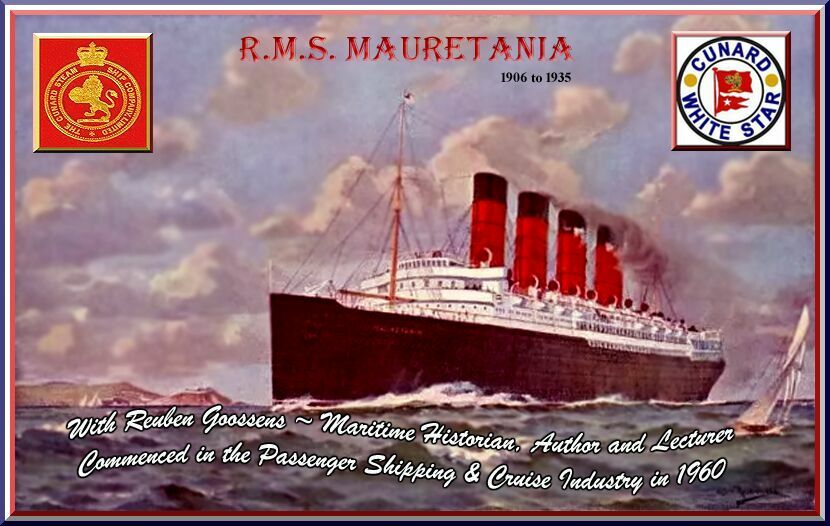
This is a pre-launch Cunard postcard of the R.M.S. Mauretania and I decided to use it for this feature’s logo
Please Note: Postcards, photographs & other images
are either from the author’s private collection or from my supporters.
photographs & images
I am sorry but some of the images shown may not be of the highest quality, but they are the best that are available
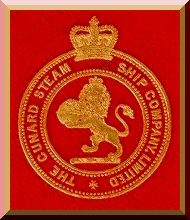
Page One
A Special Note:
I am fortunate to have a copy of the “Shipbuilder Magazine” covering the R.M.S. Mauretania, which has given me so much information not available anywhere else, thus I am sure you will thoroughly enjoy revisiting this remarkable liner!
Although this is about to go online in 2022, I actually wrote most of this back in 2004, and for some reason, I filed it away and somehow forgot about it as I had so many projects going on at the time, and together with health issues even back then it was forgotten until I rediscovered it recently together with a good number of other ships that needed some finishing touches. Some of these are already online which I have done with the help of a long standing dear friend, who I have known since 1983. He has been of a great help as obviously my health is now so poor, I just can no longer do it all by myself.
Thus enjoy the remarkable R.M.S. Mauretania for she is very special indeed!
This is a Three Page Feature, this page covers the R.M.S. Mauretania’s complete history, whist on Page Two we will tour the entire ships and view every single lounge and other Venues, and Suites, Staterooms and Cabins of course and all the other facilities she had to offer, and believe me, she was some ship! Whilst on Page Three are all those special surprises, such as some of the most amazing brochures you will have ever seen, then a number of Menus of each of the Three Classes, followed by an amazing range of spectacular Souvenirs and items of Memorabilia and finally two excellent Deck Plans, complete with links to extra-large ones which I have placed online. I am sure you will really enjoy this feature!
Reuben Goossens.
A Brief Intro:
R.M.S. Mauretania when launched and departed on her maiden voyage on November 16, 1907 was the largest moving structure ever built at 790 ft long and 31,938 GRT (Gross Registered Tons), but that was only until the R.M.S. Olympic arrived on the scene in 1911.
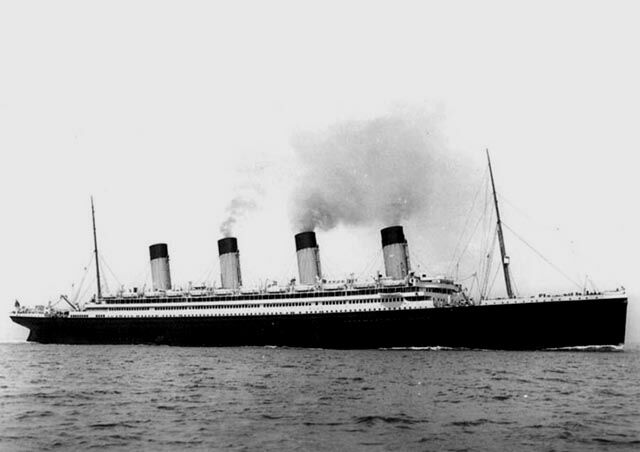
R.M.S. Olympic at 883 ft long and 45,324 GRT
How the R.M.S. Lusitania and the R.M.S. Mauretania came about:
Although this
feature is predominately about the “Mauretania” but I need to
include the “
With the
Thus in the face of the competition, “Cunard Line” really had to do something very big in order to regain the prestige and the dominance in Ocean Travel, not just for the company, but also for the United Kingdom
By 1902,
“Cunard” and the British Government had reached an agreement to
build two super liners, the 31,550 GRT “
The “
A Brief Note regarding the R.M.S. Lusitania’s Fateful End:
As is well
known, it was on May 7, 1915 when the “
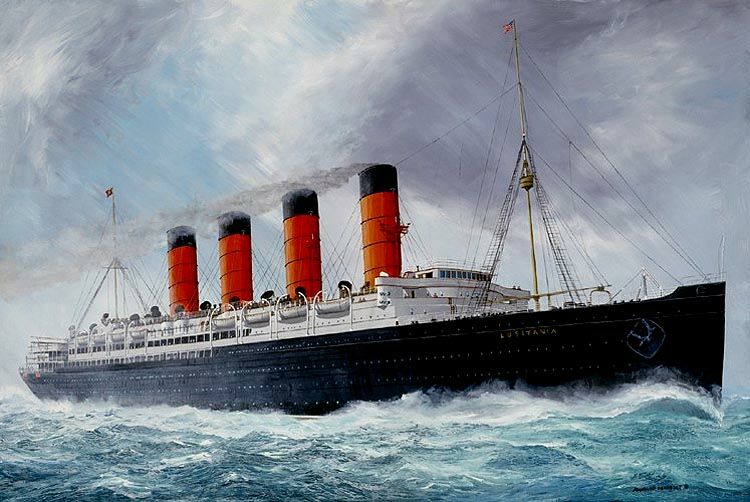
R.M.S. Lusitania a magnificent liner, which had the most unfortunate tragic end!
Designing and Completing the “Mauretania
But there is no
doubt that the “
 working from plans for an
Ocean Greyhound with a stipulated service speed of twenty-four knots in
moderate weather, according the terms of her mail subsidy contract. Although Peskett’s original configuration in 1902, was for the
“
working from plans for an
Ocean Greyhound with a stipulated service speed of twenty-four knots in
moderate weather, according the terms of her mail subsidy contract. Although Peskett’s original configuration in 1902, was for the
“
Cunard’s Naval Architect, Mr. Leonard Peskett
With plans finalised and having received a Government subsidy, “Cunard” ordered their new liner to be built by “Swan Hunter & Wigham Richardson”, Tyneside, and this exciting ship began its days with the laying of her keel on August 18, 1904 in yard 735.
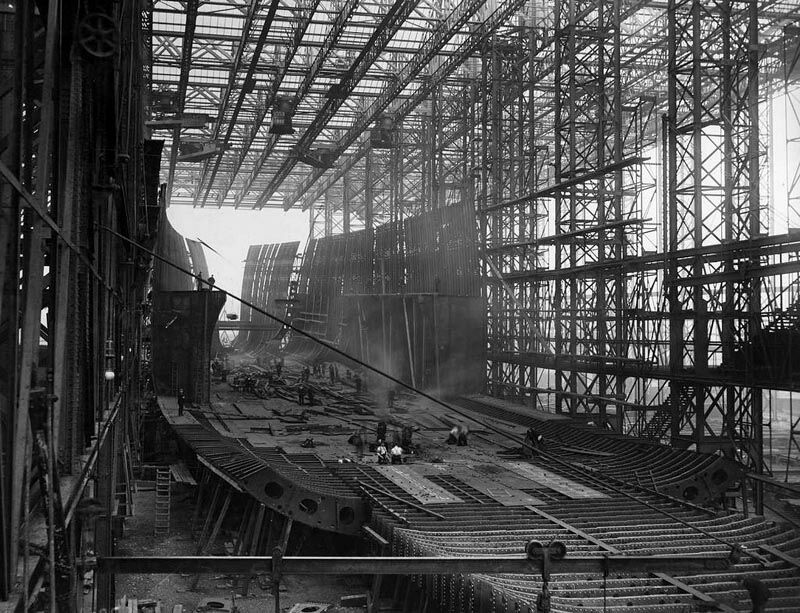
Above &
below: Three photographs of the “
Then her hull completed and her stern showing
her quadruple three blade screws
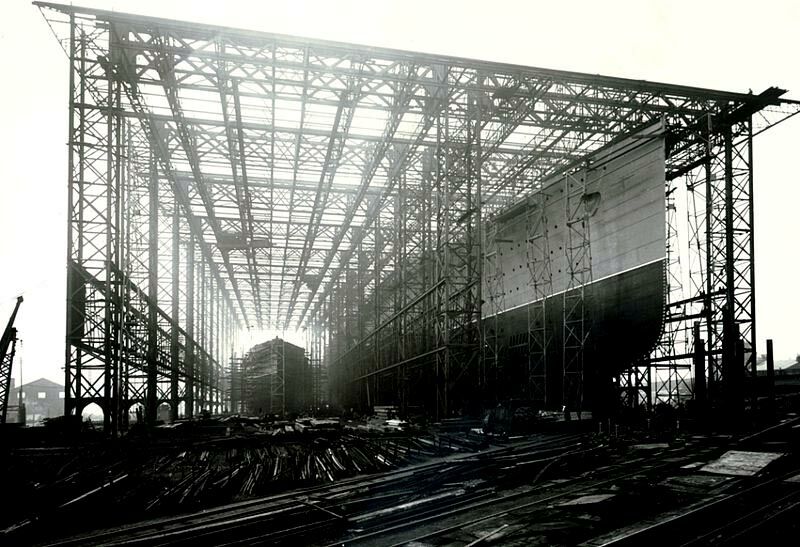
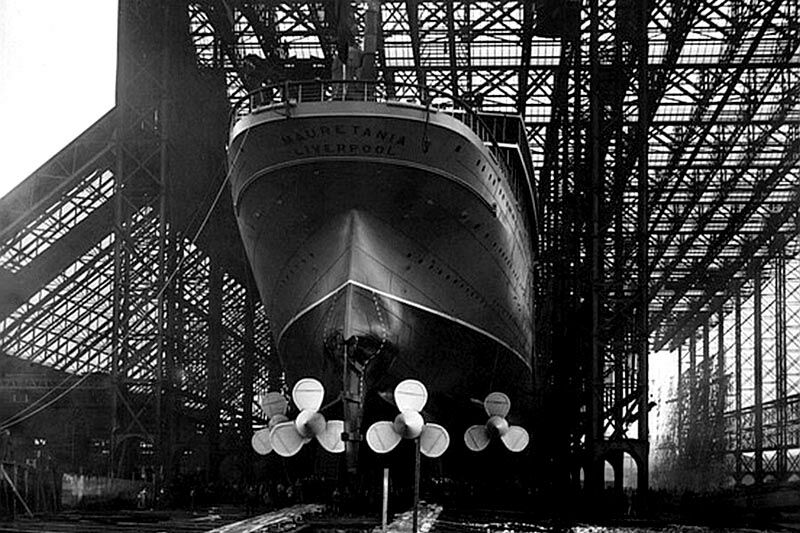
By tradition, the hull was painted in a light grey colour for photographic purposes during her launch; being a common practice of the day for the first ship in a new class, for it made the lines of the ship clearer for the black-and-white photographs.
The
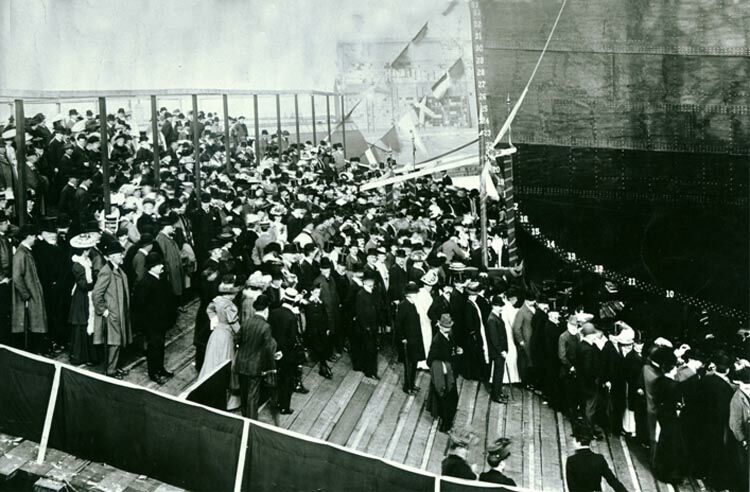
Above &
below:
Five photographs
of
3. Next we see her going down the slipway, 4. And then we see her stern slip into the River Tyne
5. Finally she is
afloat and ready to be towed to her Fit-out berth
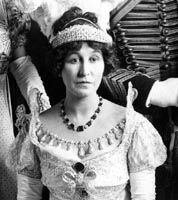
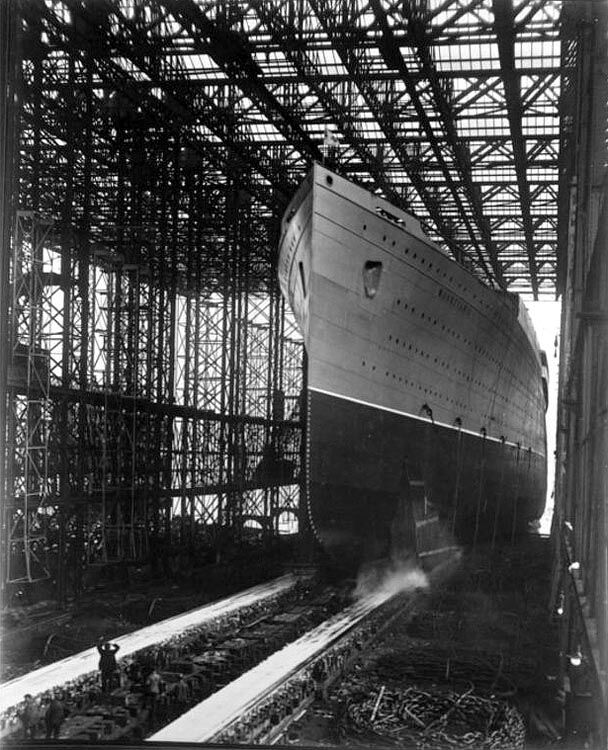
3.
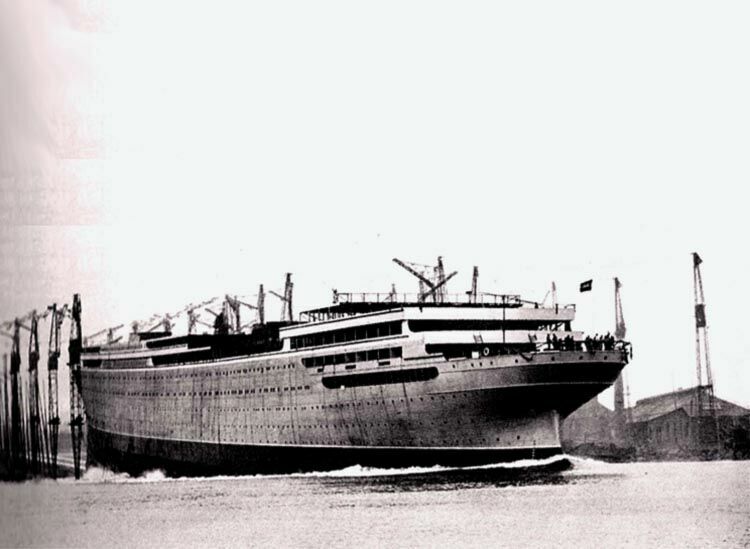
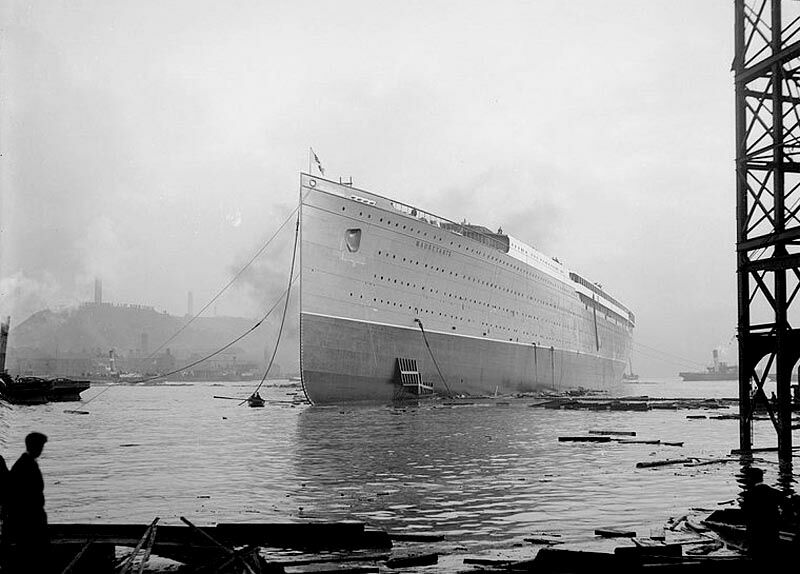
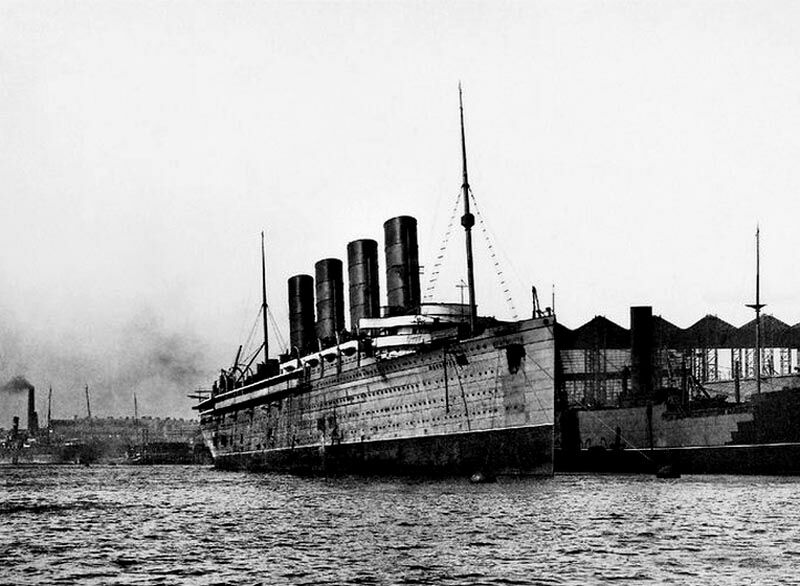
She is seen at her fit-out berth with funnels installed and some of her first lifeboats fitted
Work continued and her interiors began to take shape and carpets were fitted throughout and furnishings finally had arrived, she started to look like a liner.
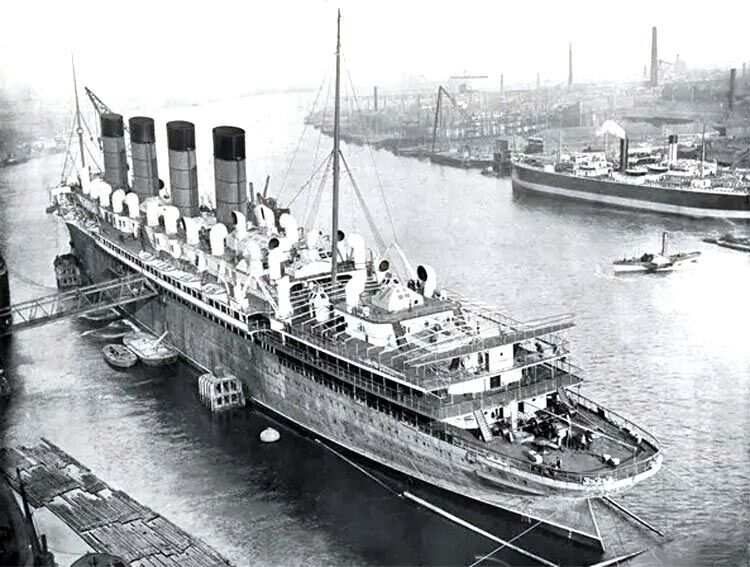
The “
In all her
fit-out took a good thirteen months to be completed, but finally on October 22,
1907, the R.M.S.
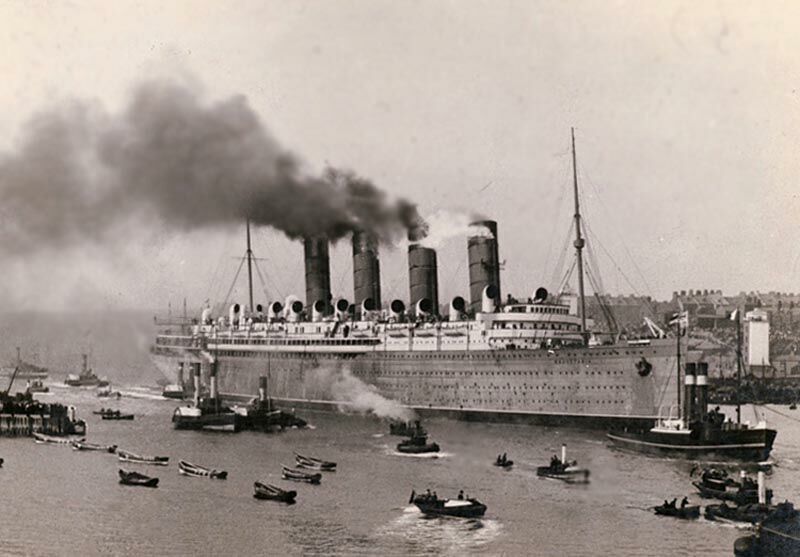
The “
to the mouth of the river heading out to sea for her Trials
But, during her speed trials there was significant vibration, whilst she had achieved maximum speed of just over 25 knots.
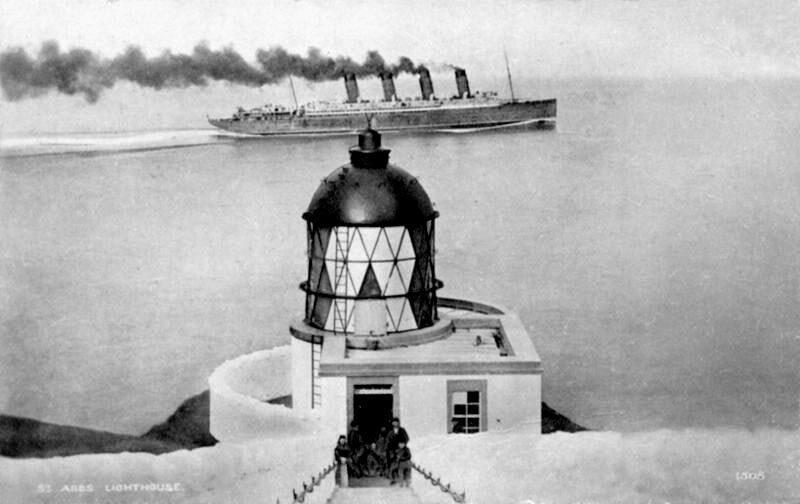
“
Thus when back
at the yard the “
When all work
had been finally completed, she was delivered to her owners at
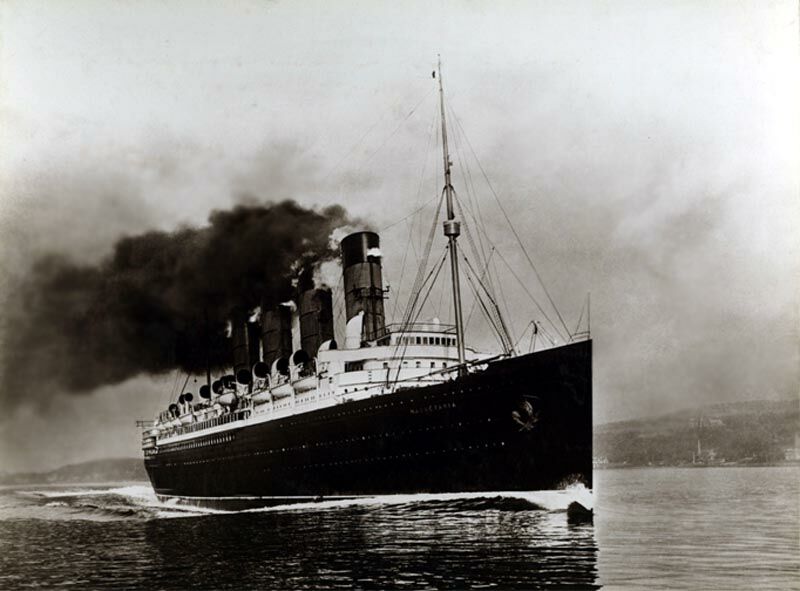
R.M.S. Mauretania
is seen during her delivery voyage to her owners at
*********************
General Ship Information:
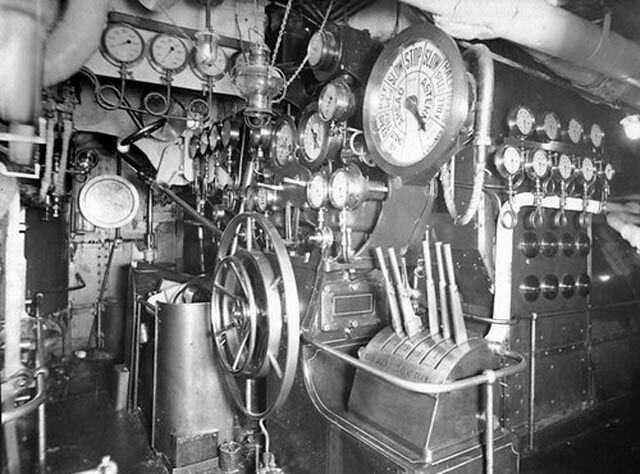
The Starting Platform in the Engine Room
Her engines were ‘direct-action Parsons steam turbines’, two being high pressure, and two low pressure.
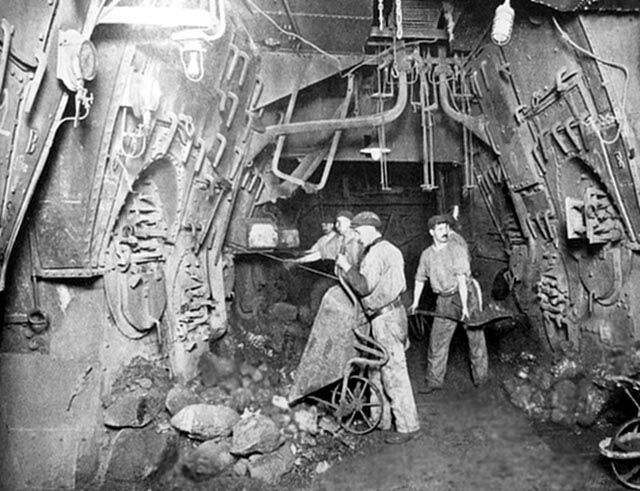
Here we see her as built when she was a coal fired ship
The “
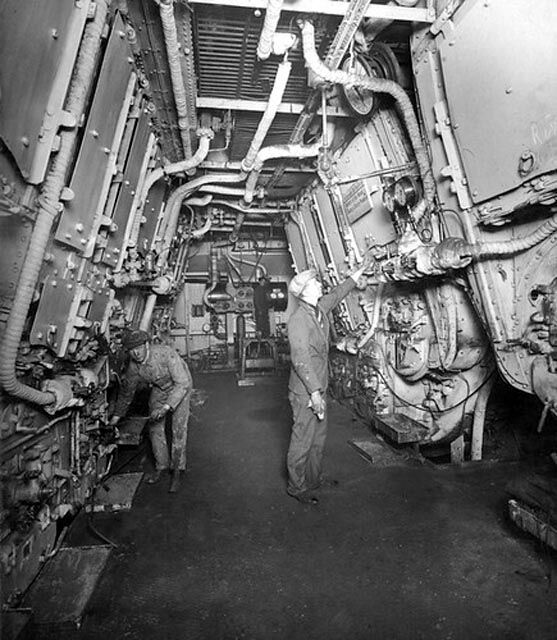
And here we see a
much cleaner boiler room when she was changed over to oil firing in 1921
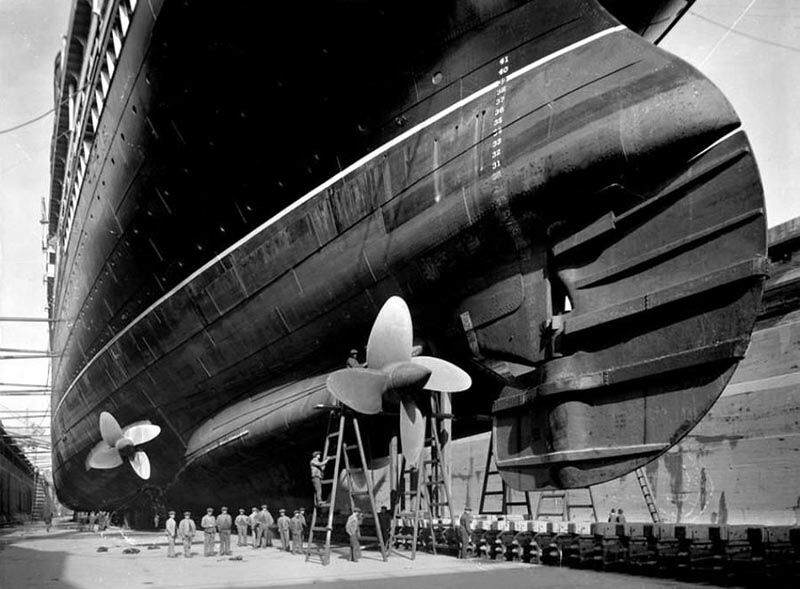
A great view of
her lower stern and those huge screws
*********************
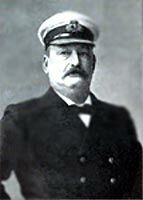 Her
Maiden Voyage:
Her
Maiden Voyage:
 Her
Maiden Voyage:
Her
Maiden Voyage: Then on the
return voyage from
*She sailed from ‘Beady Hook’ to ‘Queenstown’ - 2,807 nautical miles (5,199 km) 4d, 22h 33 m, average 23.69 knots.
She broke this record eight times eastward and once westward. But her best was as follows in 20 to 25 August 1924;
*She sailed
from ‘Ambrose ‘Light House’ to ‘
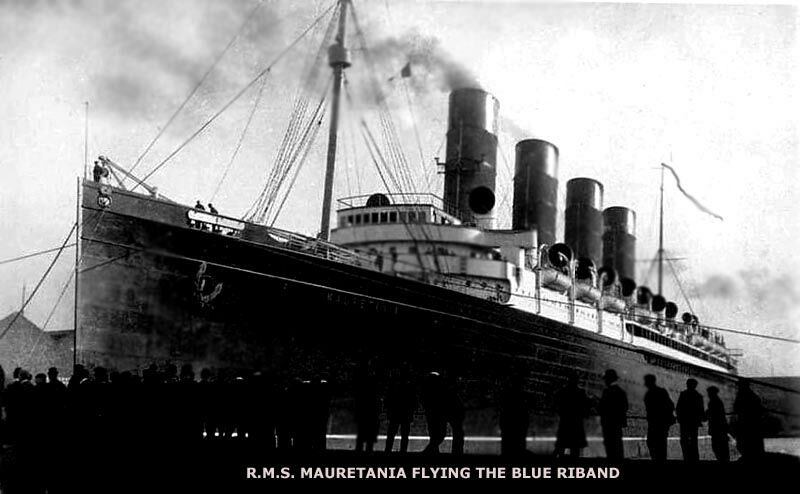
The “
HRH King George
V and Queen Mary boarded the R.M.S. Mauretania on July 11, 1913, in
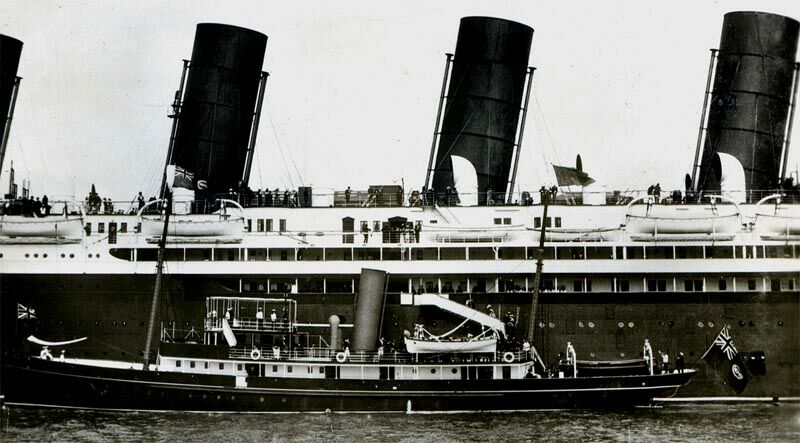
The Royal party is
seen going up the gangplank
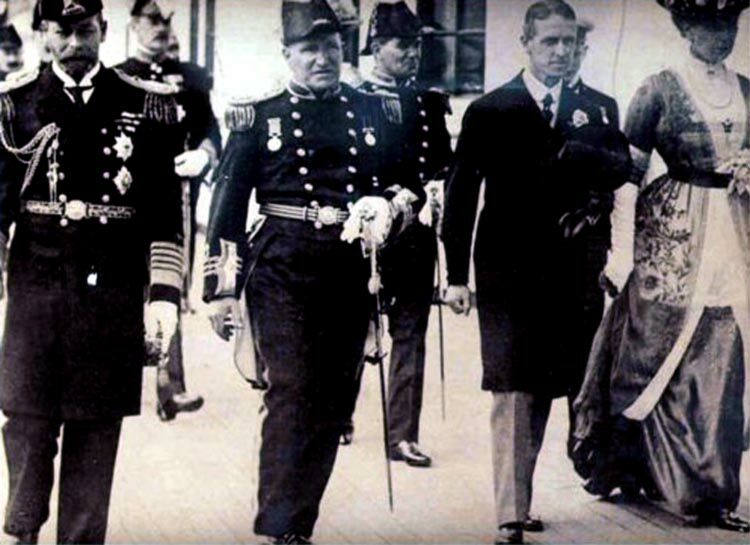
HRH King George V
and Queen Mary are seen on board the “
She sailed on
and made her last voyage to
*********************
Her Interiors:
“
The multi-level
Grand First Class Dining Saloon of ‘Straw Oak’ was decorated in
what is known as ‘Francis 1’ style and topped by a huge dome
skylight. A series of elevators, which at the time was a rare new feature for
liners had grilles composed of the relatively new lightweight aluminium that
had been installed next to
Decorations
ranged in style from French Renaissance to English Country, and the woods that
were used came from British as well as French forests. Wood panelling in her
First Class venues were supposedly as stated before, done by three hundred
craftsmen, whist the majority of the second and third class areas were executed
by the yard or were subcontracted. The “
Up on Boat Deck, (later A Deck) there were four magnificent Lounges and each one had a spectacular stained glass dome above them allowing light to enter the venue from above as it reached up onto Sun Deck.
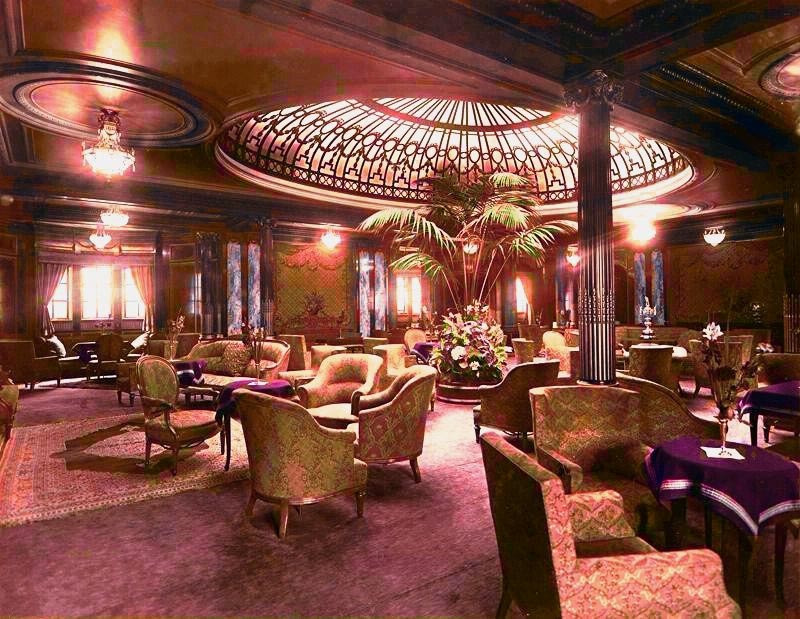
The magnificent First Class Lounge and Music Room
The interior page (Page Two) also contains her two deck plans, each having a link to a large version online.
*********************
Word War One:
On August 1,
1914, the Mauretania sailed from
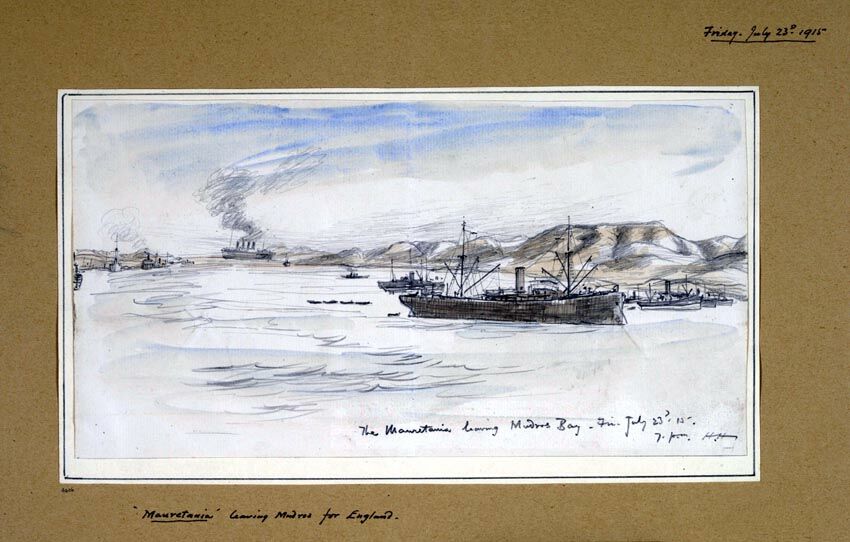
An artist’s
impression of the “
Tragically on
May 7, 1915, the very similar sister ship, the “Lusitania” which
was carrying passengers across the Atlantic to Liverpool, was tragically
torpedoed off the Old Head of Kinsale, Ireland, and
she was sunk with the loss of 1,198 men, women 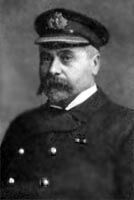 and children.
and children.
Captain Daniel Dow
Calmness and
quick thinking on the bridge was certainly connected to great courage down
below in those confined spaces for in the engine-room and stoking area the men
stood by their jobs, crowding on all revolutions to stave off the perils that
threatened them all on board.
A New Phase for the Mauretania
The world’s fastest liner received another refit as she now became a hospital ship. For this role she was painted white with buff funnels and had a thick green band around the ship and three large medical Red Cross emblems on each side and this was of course to clearly indicate that she was engaged in peaceful and a humanitarian mission.
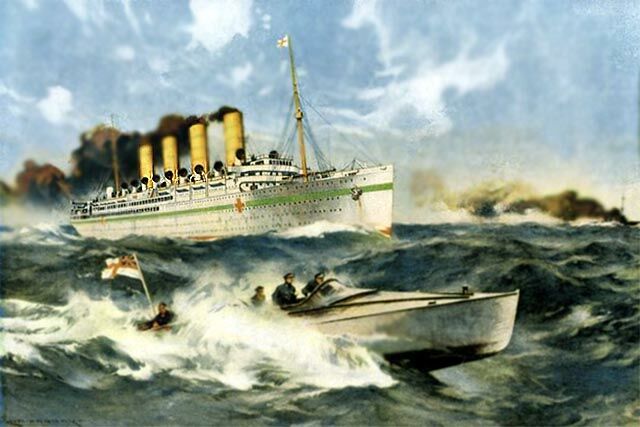
A painting of the
“
Thank you James O’Donnal, he advised me that he believes it may be by a Mr. C. A. Padday
Internally, her magnificent public rooms were turned into hospital wards were filled with bed’s, even the promenade and shelter decks were used.
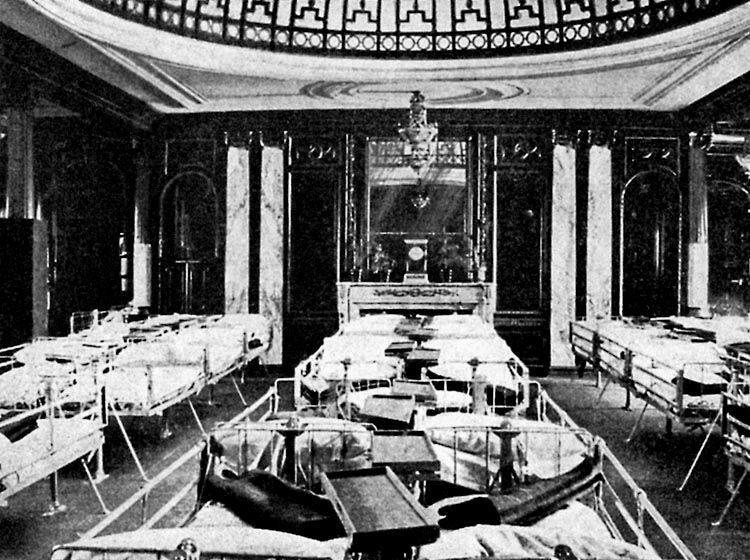
This is the magnificent Lounge and Music Salon, as seen up above,
which has been turned into a hospital ward
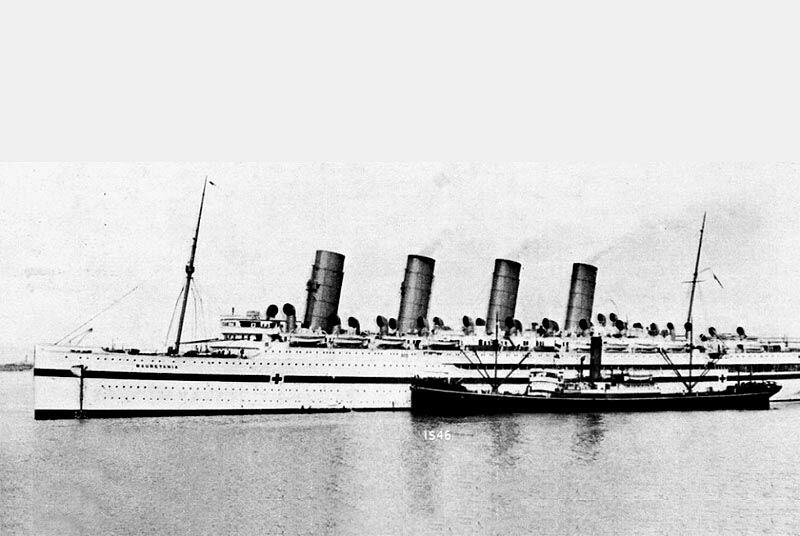
The Hospital Ship H.M.S. Mauretania
For three
voyages the
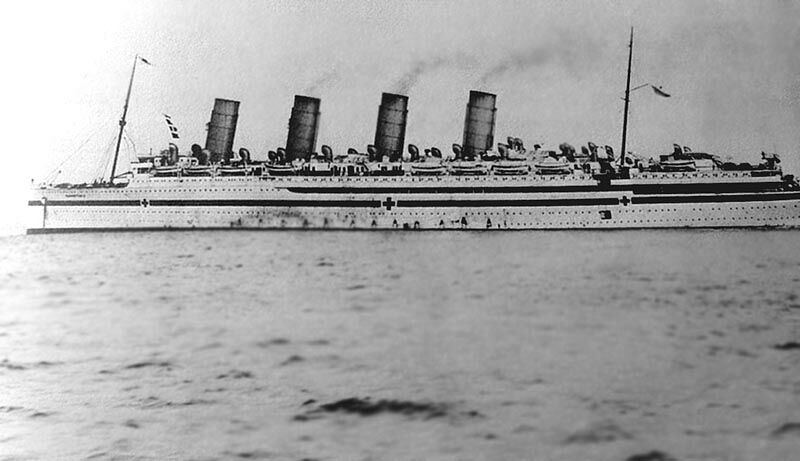
Another view of her, but just before she would end her medical service
After she had
taken on board all those who were to go home and attended to the urgent cases,
she went back to the
She continued as a hospital ship until January 25, 1916, and she was paid off and her hospital equipment was all removed and she was again laid up until she would be reactivated nine months later.
She became a Troopship Again:
H.M.S.
Mauretania was once again altered to become a troopship and in October and
November 1916 she headed to
The “Mauretania” was actually
known by the Admiralty in the
Her war duty
was certainly not yet over, for when the
Commencing in March 1918,
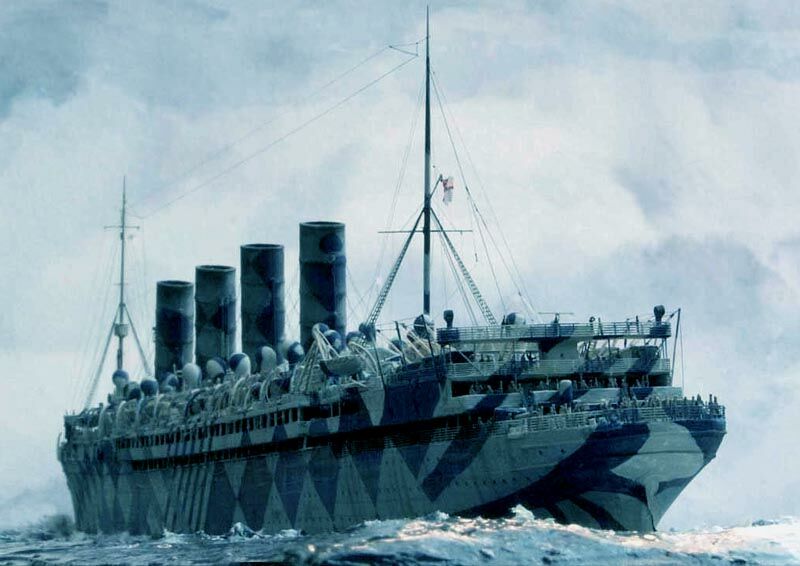
This is the first
of her Dazzle Livery
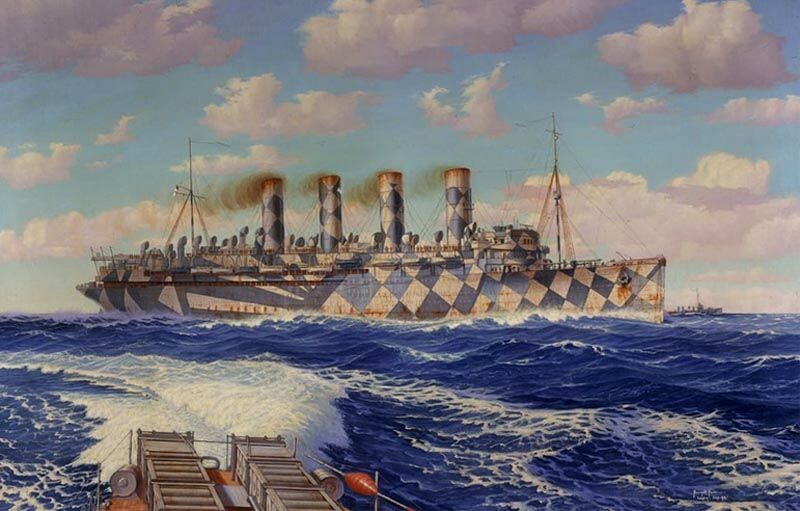
And here is a painting of the dramatic diamond blues and blacks,etc
Painting by the late Mr. Burnell Pool
Her work
continued for seven months steadily reinforcing the Western front with
divisions of American troops. Continual news updated of the wars were flashed to the
Thereafter followed a very different time for the “Mauretania” as she then commenced to return service men from the past war zones to their homes and their loved ones, having fought their wars and in many ways so many were mentally wounded.
One voyage I do
know off is that the “Mauretania” arrived in
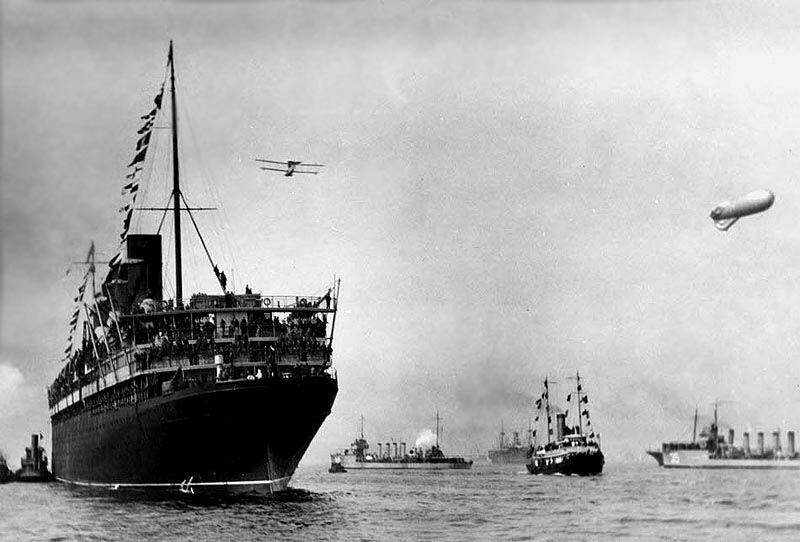
The
“Mauretania” arrives in
Then on May 27,
1919, the “
*********************
Post War Operations:
At some time, although it may have been as
early as 1912 her deck names and details were altered and became as shown in
the brackets () below.
Bridge Deck, Boat (A) Deck, Promenade
(B) Deck, Shelter (Upper C) Deck, Upper (Saloon D) Deck,
Main (E) Deck, Lower (F) Deck (no longer a passenger deck), Orlop (G) Deck (used for coal, stokehold and other spaces).
Please Note: Several Deck Plans are shown on Page Two,
which also contains all her magnificent interiors.
Having been restored to being a passenger liner again, R.M.S. Mauretania finally returned to her Trans-Atlantic services on September 21, 1919. But due to her very busy schedule, she was unable to halt her services in order for her to have an extensive refit that had been scheduled for 1920.
But believe it or not and this sounds very strange, but it is not, her fortunes increased, for in July 1921, due to an outbreak of a fire which gutted cabins on the Lower (E) Deck and did some damage one deck up on Main (D) Deck above. Thus Cunard Line obviously was forced to remove her from service and gave that much needed overhaul. They sent her back to the company that built her; “Swan Hunter & Wigham Richardson” on the River Tyne.
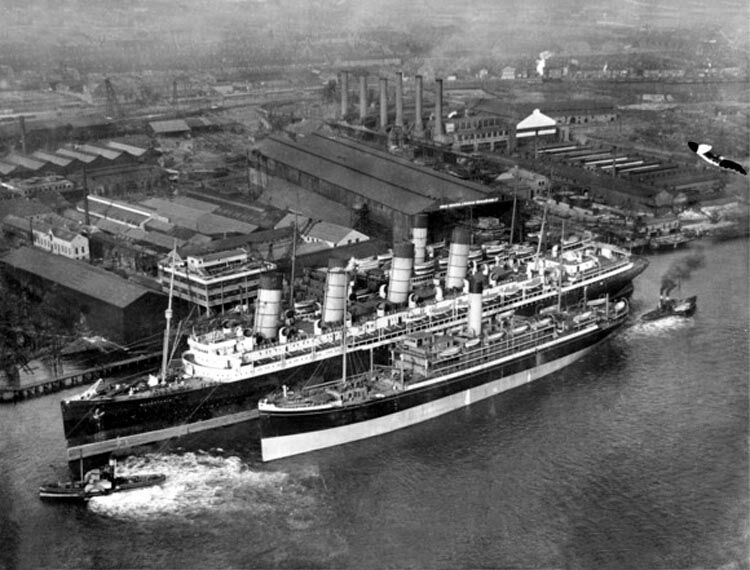
R.M.S. Mauretania is seen moored at the “Swan Hunter and Wigham Richardson Ltd”
shipbuilding yard, on the River Tyne in 1921 for her overhaul
Whilst there
she was converted from coal burning to oil burning, for obviously
“Cunard” had been fully aware of the countless advantages of oil as
a fuel, in addition the obvious repairs were also made and her promenade
was also enclosed. The “
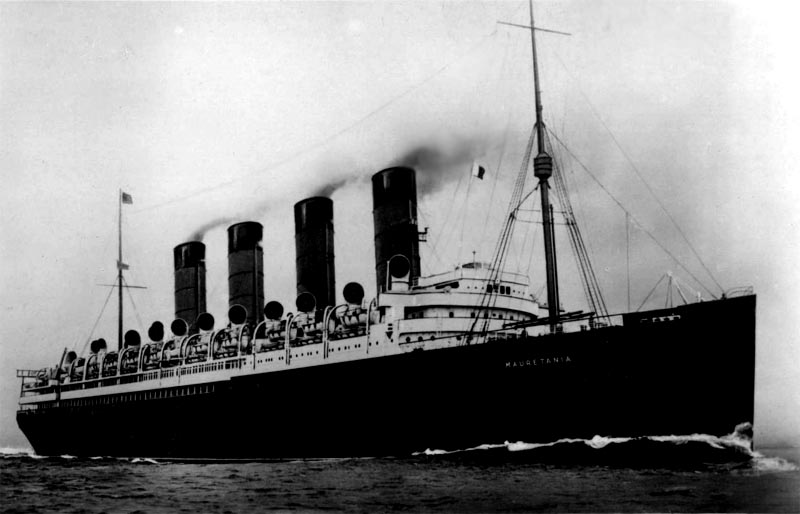
R.M.S. Mauretania with her glass enclosed promenade is about to arrive in a port
After her
conversion to oil burning, Cunard did notice that the “
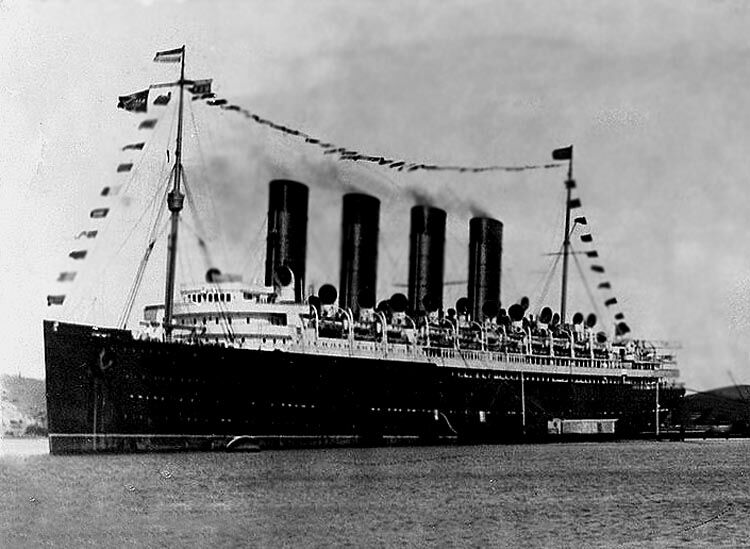
The
“Mauretania is seen at anchor in
On November 27,
1929, the “Mauretania” collided with a train ferry near the Robbins Reef Light just
after leaving
In 1927
the Mauretania was given an overhaul and was reconditioned at Liverpool,
when completed she arrived at
In 1930, with a
combination of the Great Depression and newer competitors on the
Atlantic service the “Mauretania” became a
dedicated cruise ship operating six day cruises from
Then on November 19, 1930, the Captain and his wife Mrs. Carlson as well as the with 26 crew members, not to forget the ships cat, were all dramatically rescued from the Swedish cargo ship the S.S. Ovidia which foundered in the Atlantic Ocean 400 nautical miles south east of Cape Race, Newfoundland, by the “Mauretania”.
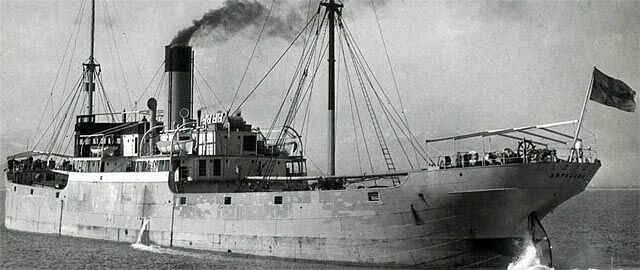
The 3,343 GRT S.S. Ovidia seen in better days
The
“Mauretania” was now operating more and more cruises in the Mediterranean,
the West Indies, and the
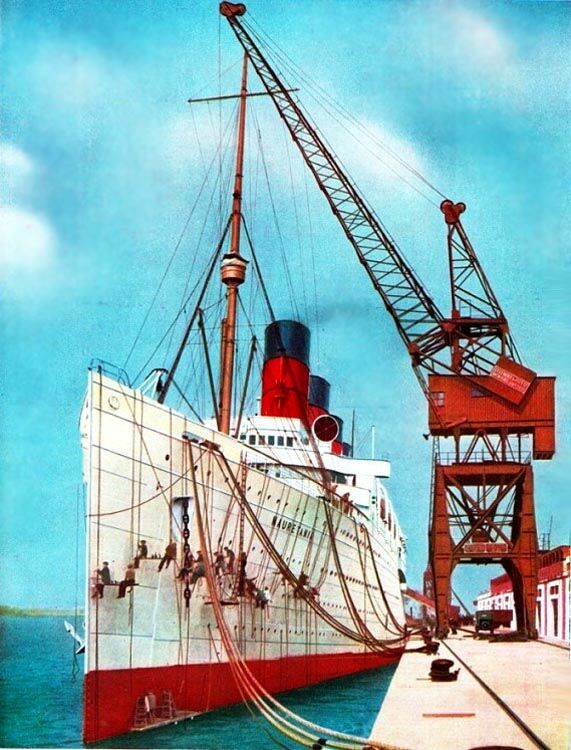
Her new all white cruising look
To reduce the effects of heat Cunard decided it would be best to paint her all white and that was completed in June 1933, and she looked very much a cruise ship.
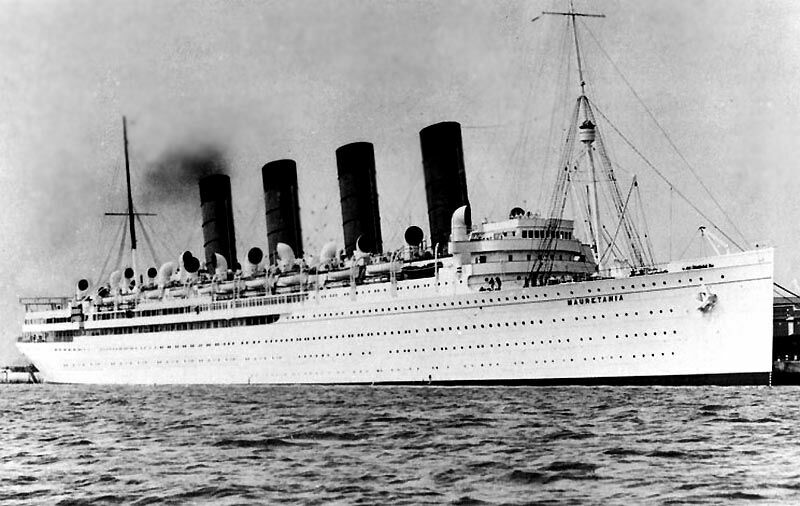
The all white
cruise Ships “Mauretania” is seen here at
When Cunard
Line merged with White Star Line in 1934,
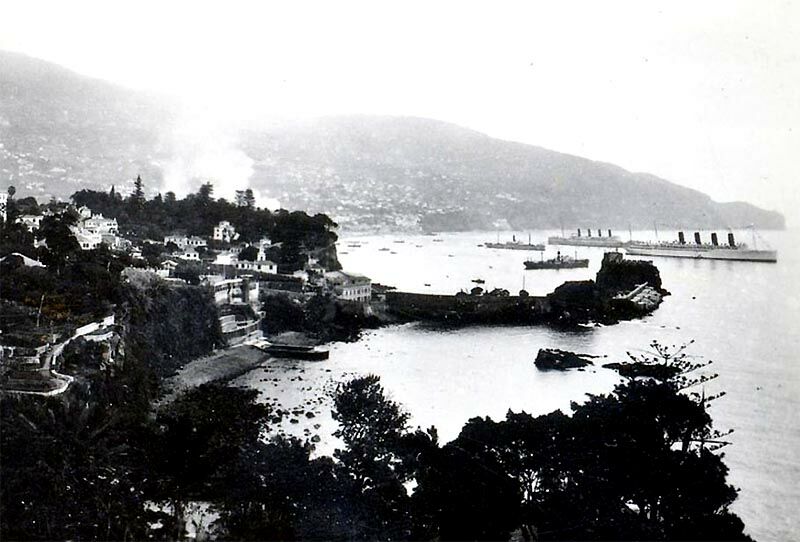
The Mauretania
(left) and the
Then suddenly a
decision was made, which could not have been arrived at easily,
“Cunard” decided to withdraw the “Mauretania” from
service and following her final passenger sailing from
During her
final voyage she averaged a speed of 24 knots, which was still a remarkable
speed for this old liner now in her final days. After two further cruises to
the West Indies she returned to
A buyer soon
came on scene and the “
On July 1,
1935, the grand old dame, the R.M.S. Mauretania departed for the very last time
from
On July 3,
she reached the “Firth of Forth” and she passed under the
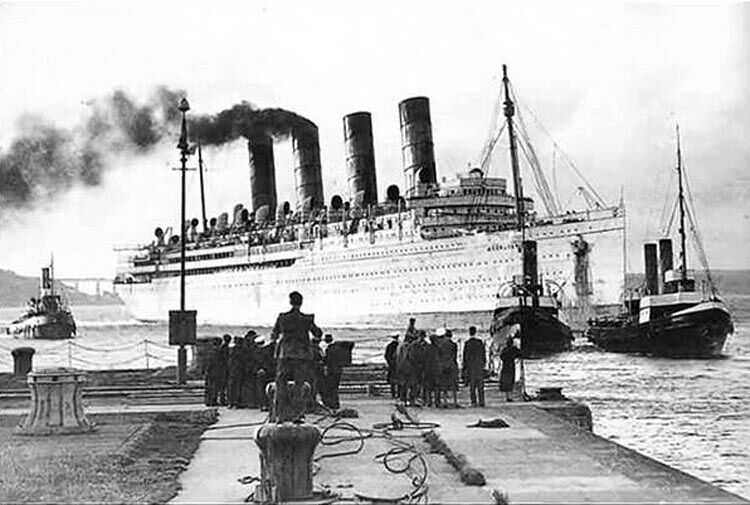
The “
Among the
admirers of the “
One of her
Captain’s on the ship’s retirement gave her the most fitting
epitaph of them all. Captain Sir Arthur Rostron said;
“She gave of her best, served Cunard well, was an honour and a credit to
her builders, to her owners and to
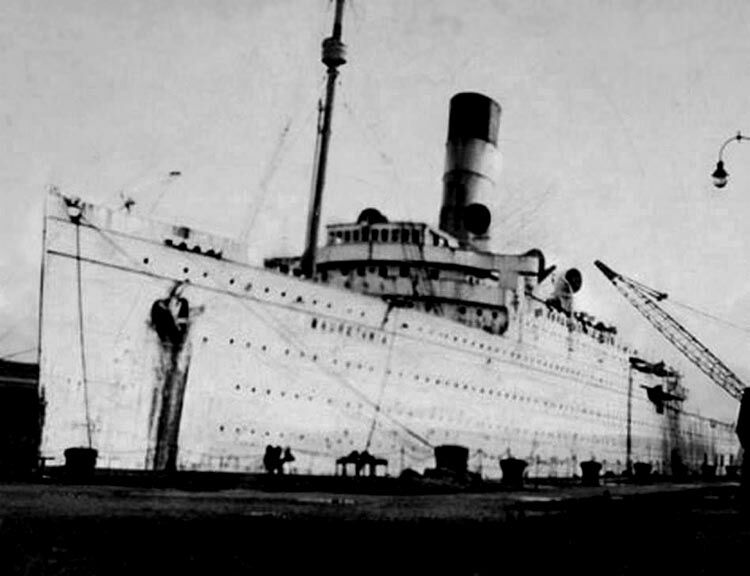
The once magnificent liner is seen slowly disappearing!
Few liners
during their active service received the masses of affections as was lavished
upon the “
*********************
Specifications & Details - R.M.S. Mauretania:
Name:
Nickname: “The Maury”.
Type: Passenger Liner & Refrigerated Cargo Ship.
Holds: 2 forward, with 4 insulated spaces on Orlop Deck,
. and a general cargo area over two decks below.
Owner: Cunard Line 1906–1914.
. Royal Navy 1914-1919.
. Cunard Line 1919-1934.
. Cunard White Star Line 1934–1935.
Operator: Cunard.
Port of registry:
Route: Liverpool,
later Southampton to
Builder: “Swan
Hunter & Wigham Richardson”,
Laid down: August 18, 1904.
Yard No: 735.
Launched: September 20, 1906, by the Duchess of Roxburghe.
Trials: October 22, 1907.
Delivered: November 11, 1907.
Maiden Voyage: November 16, 1907.
Tonnage: 31,938 GRT.
Length: 790 ft - 240.8 m.
Beam: 88 ft - 26.8 m.
Draught: 33 ft - 10.1 m.
Depth: 33.5 ft - 10.2 m.
Installed Power: Direct-action Parsons steam turbines (two high pressure, two low pressure) - 68,000 shp (51,000 kW) nominal at launch, 76,000 shp (57,000 kW) on record run, later increased in 1928 to 90,000 shp (67,000 kW) July 1929.
Propellers: Quadruple three bladed screws as built.
. Quadruple four bladed screws in 1908.
Speed: 25 Knots service speed, 28.5 knots maximum.
Accommodations: 2,165 passengers total.
. 563 First Class, 464 Second Class & 1,138 Third Class.
Decks: 6 passenger decks, 8 in total.
Crew: 812 (See separate crew list below).
WW1: During the war she was known by the Admiralty as H.M.S. Tuberose, but her actual name was never changed on her hull.
Out of service: September 1934.
Fate: Departed
to her new owner “Metal Industries” ship breaker on July 1, 1935
arriving on the 4th at
Complete Crew List:
. Captain 1.
. Officers 8.
. Petty Officers 15
. Marcony Operators 2.
. Chief Engineer 1.
. Engineers 29.
. Refrigerating Engineers 3.
. Pursers 3.
. Chief Stewrad 1.
. Head Chef 1.
. Cooks 40.
. Bakers 2.
. Leading Stewards 4.
. Matrons 2.
. Stewards 305.
. Stewardesses 10.
. Doctor 1.
. Seamen 40.
. Carpenters 2.
. Joiners 1.
. Greasers 21.
. Firemen 192.
. Trimmers 120.
. Typists 2.
. Mail Sortists 3.
. Barbers 2.
. Inspector 1.
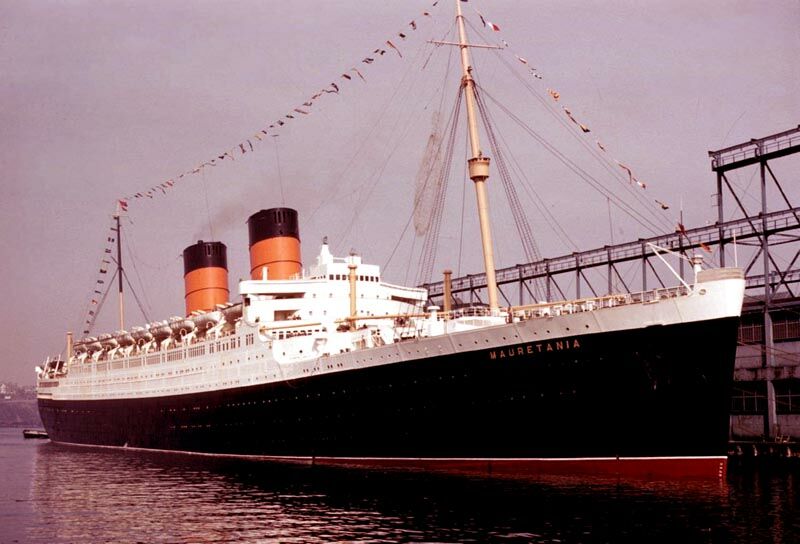
R.M.S. Mauretania
(2) - 1938
*********************
Remembering the Great …
R.M.S. Mauretania
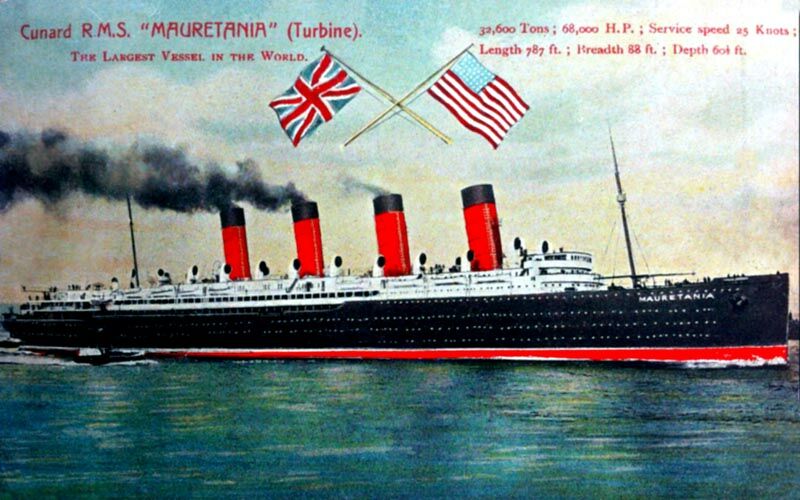
A very early postcard of the R.M.S. Mauretania (1) was released within days of her maiden voyage
R.M.S.
Mauretania 1 & 2 - INDEX:
R.M.S. Mauretania (1) … Page Two
- Her Interiors, Deck Plans and other items.
R.M.S. Mauretania (1) … Page Three
- Deck Plans and other items.
“Blue Water Liners sailing to the distant shores.
I watched them come, I watched
them go and I watched them die.”
Featuring over 1,435 Classic Passenger Liners, Passenger-Cargo Liners & Classic Cruise Ships!
Or ENTER HERE
For interest: Sadly an email service to ssMaritime is no
longer available, due to the author’s old age and chronic illness as well
as being disabled, etc. In the past ssMaritime received well over 120 emails
per day, but
*********************
ssMaritime.com & ssMaritime.net
The Author has been in Passenger Shipping & the Cruise Industry for well over 60 years
In addition he was the founder of “Save the Classic Liners Campaign” in 1990.
Please Note: ssmaritime and associated sites are 100% non-commercial and the
author seeks no funding or favours of any
shape or form, never have and never will!
Photographs on ssmaritime and associate pages are by; the author or from the author’s private collection. In
addition there are some images that have been provided by Shipping Companies and
private photographers or collectors. Credit is given to all contributors.
However, there are some photographs provided to me without details regarding
the photographer/owner concerned.
This notice covers all pages; although, and I have done my best to ensure that all photographs
are duly credited and that this notice is displaced on each page, that is, when
a page is updated!
ssMaritime is owned
& © Copyright by

